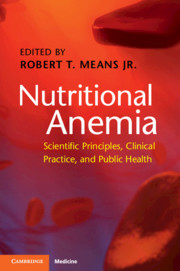Book contents
- Nutritional Anemia
- Nutritional Anemia
- Copyright page
- Dedication
- Contents
- Contributors
- Preface and Acknowledgments
- Section 1 Overview
- Section 2 Iron Deficiency
- Section 3 Copper and Vitamin D Deficiency
- Section 4 Special Topics
- Chapter 12 Nutritional Anemia during Pregnancy
- Chapter 13 Vegetarianism and Other Restricted Diets
- Chapter 14 Nutritional Syndromes with Anemia
- Chapter 15 Anemia Following Bariatric Surgery
- Index
- References
Chapter 13 - Vegetarianism and Other Restricted Diets
from Section 4 - Special Topics
Published online by Cambridge University Press: 02 April 2019
- Nutritional Anemia
- Nutritional Anemia
- Copyright page
- Dedication
- Contents
- Contributors
- Preface and Acknowledgments
- Section 1 Overview
- Section 2 Iron Deficiency
- Section 3 Copper and Vitamin D Deficiency
- Section 4 Special Topics
- Chapter 12 Nutritional Anemia during Pregnancy
- Chapter 13 Vegetarianism and Other Restricted Diets
- Chapter 14 Nutritional Syndromes with Anemia
- Chapter 15 Anemia Following Bariatric Surgery
- Index
- References
- Type
- Chapter
- Information
- Nutritional AnemiaScientific Principles, Clinical Practice, and Public Health, pp. 153 - 174Publisher: Cambridge University PressPrint publication year: 2019
References
- 1
- Cited by

